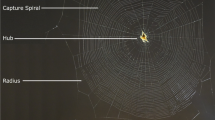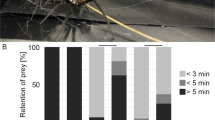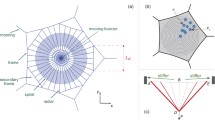Summary
Pretensile forces were measured in individual threads of intact spider webs. In the orb web of Araneus diadematus forces decrease from mooring threads to frame threads and radii, a typical ratio being 10∶7∶1. The smaller number of radii in the upper than in the lower half of the orb is paralleled by force ratios of 2∶1 to 3∶1. A similar difference between radii built first during web construction and radii added after completion of the frame underlines the importance of the former as part of the scaffolding. High tensions in the auxiliary spiral stabilize the radii in addition to providing a pathway for the spider when inserting the sticky spiral. Radial pretension (F) changes with spider mass (m). F/m is similar for different animals indicating an adaptation of radial forces to those resulting from spider mass. Several observations suggest tension control by the spider. When forced to anchor its web to thin flexible rods tension in the threads remains in the normal range. Tension values are similar in the webs of A. diadematus, Zygiella x-notata, Nuctenea umbratica, and Nephila clavipes indicating independence from details of web geometry. Only the mooring threads of Nephila show unusually large forces suggesting a narrower working range of tensions for the catching area than for the scaffolding.
Similar content being viewed by others
References
Blackwall J (1830) On the manner in which the geometric spiders construct their nets. Zool J 5:181–188
Brown SG, Hill EM, Goist KE, Wenzl PA, Christenson TE (1985) Ecological and seasonal variations in a free-moving population of the golden-web spider, Nephila clavipes. Bull Brit Arachnol Soc 6:313–319
Coddington J, Sobrevila C (1987) Web manipulation and two stereotyped attack behaviors in the ogrefaced spider Deinopis spinosus Marx (Araneae, Deinopidae). J Arachnol 15:213–225
Craig CL (1987a) The significance of spider size to the diversification of spider-web architectures and spider reproductive modes. Am Nat 129:47–68
Craig CL (1987b) The ecological and evolutionary interdependence between web architecture and web silk spun by orb web weaving spiders. Biol J Linn Soc 30:135–162
Denny M (1976) The physical properties of spider's silk and their role in the design of orbwebs. J Exp Biol 65:483–506
Denny M (1980) Silks — their properties and function. Soc Exp Biol Symp 34:247–272
De Wilde J (1943) Some physical properties of the spinning threads of Aranea diadema L. Arch Néerl Physiol 28:118–131
Eberhard WG (1981) Construction behavior and the distribution of tensions in orb webs. Bull Arachnol Soc 5:189–204
Eberhard WG (1982) Behavioral characters for the higher classification of orb-weaving spiders. Evolution 36:1067–1095
Eberhard WG (1987) Effects of gravity on temporary spiral construction by Leucauge mariana (Araneae: Araneidae). J Ethol 5:29–36
Eberhard WG (1988) Memory of distances and direction moved as cues during temporary spiral construction in the spider Leucauge mariana (Araneae: Araneidae). J Insect Behav 1:51–66
Eberhard WG (1990) Function and phylogeny of spider webs. Annu Rev Ecol Syst 21: 341–372
Gräser K (1973) Die Übertragungseigenschaften des Netzes von Zygiella x-notata (Clerck) für transversale Sinusschwingungen im niederen Frequenzbereich und Frequenzanalyse beutetiererregter Netzvibrationen. Diplomarbeit, Universität Frankfurt am Main, Federal Republic of Germany
Hieber CS (1984) Orb-web orientation and modification by the spiders Araneus diadematus and Araneus gemmoides (Araneae: Araneidae) in response to wind and light. Z Tierpsychol 65:250–260
Jackson RR (1971) Fine structure of thread connections in the orb web of Araneus diadematus. Psyche 78:12–31
Jackson RR (1973) Nomenclature for orb web thread connections. Bull Brit Arachnol Soc 2:125–126
Kavanagh EJ, Tillinghast EK (1979) Fibrous and adhesive components of the orb webs of Araneus trifolium and Argiope trifasciata. J Morphol 160:17–31
Krakauer T (1972) Thermal responses of the orb-weaving spider Nephila clavipes (Araneae: Argiopidae). Am Midl Nat 88:245–250
Kullmann E (1975) Die Produktion und Funktion von Spinnenfäden und Spinngeweben. In: Otto F (Hrsg) Netze in Natur und Technik. Veröffentlichung des Instituts für leichte Flächentragwerke (IL8), Universität Stuttgart, pp 318–378
Le Guelte L (1969) Comportement de construction de l'araignée et tension des premiers rayons de sa toile. Rev Comp Animal 3:27–32
Masters WM (1984) Vibrations in the orb webs of Nuctenea sclopetaria (Araneidae). I. Transmission through the web. Behav Ecol Sociobiol 15:207–215
Mayer G (1952) Untersuchungen über Herstellung und Struktur des Radnetzes von Aranea diadema und Zilla x-notata mit besonderer Berücksichtigung des Unterschiedes von Jugend- und Altersnetzen. Z Tierpsychol 9:237–362
Mönch E (1971) Einführungsvorlesung Technische Mechanik. R. Oldenbourg, München Wien
Moore CW (1977) The life cycle, habitat and variation in selected web parameters in the spider, Nephila clavipes Koch (Araneidae). Am Midl Nat 98:95–108
Nentwig W (1985) Prey analysis of four species of tropical orbweaving spiders (Araneae: Araneidae) and a comparison with araneids of the temperate zone. Oecologia (Berlin) 66:580–594
Opell BD (1985) Web-monitoring forces exerted by orb-web and triangle-web spiders of the family Uloboridae. Can J Zool 63:580–583
Opell BD (1987) Changes in web-monitoring forces associated with web reduction in the spider family Uloboridae. Can J Zool 65:1028–1034
Peters HM (1937a) Studien am Netz der Kreuzspinne (Aranea diadema). I. Die Grundstruktur des Netzes und Beziehungen zum Bauplan des Spinnenkörpers. Z Morphol Ökol Tiere 32:613–649
Peters HM (1937b) Studien am Netz der Kreuzspinne (Aranea diadema L.). II. Über die Herstellung des Rahmens, der Radialfäden und der Hilfsspirale. Z Morphol Ökol Tiere 33:128–150
Peters HM (1951) Untersuchungen über die Proportionierung im Spinnen-Netz. Z Naturforsch 6b:90–107
Reed CF, Witt PN, Jones RL (1965) The measuring function of the first legs of Araneus diadematus CL. Behaviour 25:98–119
Savory T (1952) The Spider's Web. Warne, London
Shear (ed) (1986) Spiders: webs, behavior, and evolution. Stanford Univ Press, Stanford California
Siegel S (1987) Nichtparametrische statistische Methoden. Fachbuchhandlung für Psychologie, Verlagsabteilung, Eschborn
Tilquin A (1942) La toile géométrique des araignées. Presses Univ, Paris
Vollrath F (1986) Gravity as an orientation guide during webconstruction in the orb spider Araneus diadematus (Araneae, Araneidae). J Comp Physiol A 159:275–280
Vollrath F (1987) Altered geometry of webs in spiders with regenerated legs. Nature 328:247–248
Wainwright SA, Biggs WD, Currey JD, Gosline JM (1976) Mechanical design in organisms. Princeton Univ Press, Princeton, pp 353–354
Wiehle H (1929) Weitere Beiträge zur Biologie der Araneen, insbesondere zur Kenntnis des Radnetzbaues. Z Morph Ökol Tiere 15:262–308
Wiehle H (1931) Neue Beiträge zur Kenntnis des Fanggewebes der Spinnen aus den Familien Argiopidae, Uloboridae und Theridiidae. Z Morphol Ökol Tiere 22:349–400
Witt PN (1971) Instructions for working with web-building spiders in the laboratory. Bioscience 21:23–25
Witt PN, Scarboro MB, Daniels R, Peakall DB, Ganse RL (1977) Spider web-building in outer space: evaluation of records from the skylab spider experiment. J Arachnol 4: 115–124
Yamashita S (1985) Photoreceptor cells in the spider eye: spectral sensitivity and efferent control. In: Barth FG (ed) Neurobiology of arachnids. Springer, Berlin Heidelberg New York, pp 103–117
Author information
Authors and Affiliations
Rights and permissions
About this article
Cite this article
Wirth, E., Barth, F.G. Forces in the spider orb web. J Comp Physiol A 171, 359–371 (1992). https://doi.org/10.1007/BF00223966
Accepted:
Issue Date:
DOI: https://doi.org/10.1007/BF00223966




